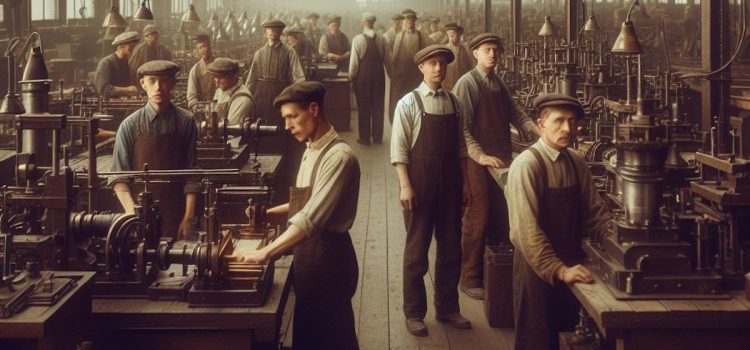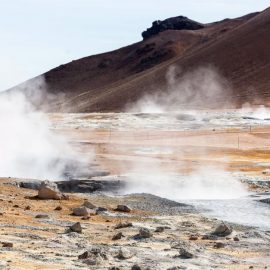
What’s the history of the labor movement in America? Why did they organize? What obstacles have they had to deal with?
Howard Zinn explains that in the decades following the Civil War, the US industrialized at a rapid pace and became a global power—at the expense of American laborers. He explores the consequences of industrialization, how laborers resisted them, and the challenges the labor movement faced.
Continue reading to learn about the labor movement in America, according to A People’s History of the United States.
The Labor Movement in America
Zinn places his history of the labor movement in America in the context of the Industrial Revolution and beyond. He explains that, while the US started industrializing early in the 19th century, the process accelerated after the Civil War. Capitalists used their political power as well as violence and corruption to control the government and make massive amounts of wealth. In the meantime, average people suffered. Factory employees worked over 12 hours a day in horrible conditions just to scrape by, then return to their dirty, cramped homes. Accidents were common, disease was rampant in urban slums, and average life expectancy plummeted.
(Shortform note: While Zinn focuses on how industrialization further impoverished the poor, sociologist C. Wright Mills (The Power Elite) explores how it caused the upper and middle classes to shrink by concentrating wealth in the hands of fewer elites. According to Mills, new industrial technologies like railroads and telegrams allowed individual elites to operate on a much larger scale than before. Those who were able to take advantage of these developments spread their wealth and influence nationally, outcompeting and replacing the country’s existing networks of locally based, smaller-scale elites.)
In response to their grim conditions, workers organized (illegally at the time) and advocated better working conditions, higher pay, and other benefits. This usually involved striking, or laborers refusing to work until their demands were met. Often, capitalists, police, hired thugs, and sometimes the National Guard attacked and killed strikers. Initially, labor organization was sporadic, small, and rarely effective—employees of one plant would walk off the job in protest only to be replaced by other people looking for work. But over time, it grew in scale and ambition. Zinn notes several important elements of the labor movement: trade unions, socialism, and radical organizers.
(Shortform note: Compared to other major industrial powers of the era, US labor history is particularly long and tumultuous. While countries like Germany, the UK, and France legalized labor unions by the end of the 19th century, they weren’t fully legal in the US until 1935. In addition, scholars generally recognize that the US has the most violent labor history of any country in the world—largely due to management and law enforcement refusing to recognize unions. As we discuss the methods and struggles of the American labor movement, keep in mind that the challenges they faced were uniquely difficult.)
1) Trade Unions
Zinn explains that the largest form of labor organization were trade unions: organizations of workers within a specific trade, such as teachers and longshoremen. These unions attempted to monopolize their specific form of labor, then used this monopoly to make demands of their employers.
Trade unions also worked together through larger organizations such as the American Federation of Labor (AFL), founded in 1886. These organizations allowed trade unions to coordinate their strikes across an industry or even across multiple industries, giving them more leverage to make greater demands. But like many of the trade unions it consisted of, the AFL didn’t represent all American workers—Blacks, women, and immigrants couldn’t join for several decades. However, the AFL still fought hard for important rights like shorter working days, better working conditions, and a ban on child labor.
(Shortform note: Trade unions were a relatively new concept when they reached the US, having only been invented a few decades prior, in the mid-to-late 18th century. Before people formed trade unions in Europe and the US, organized labor typically took the form of violent and sporadic events such as peasant rebellions. In addition, it was often craftsmen, who owned and ran their own businesses, organizing for labor reform rather than wage-earning employees. Trade unions developed in large part as a response to the sudden change of conditions for many people due to industrialization—laborers faced harsher working conditions and worked in closer proximity to their coworkers than ever before, giving them the motive and means to organize.)
2) Socialists and the Socialist Party of America
Zinn explains that socialism, or the political and economic ideology promoting collective ownership of property, rapidly gained popularity in late 19th and early 20th century America. Socialists came from a number of backgrounds: They were trade unionists, rural populists, idealistic academics, immigrants, and so on. Their politics were anti-war, anti-imperialist, pro-worker’s rights, pro-government regulation, and pro-social safety nets. Socialists made their largest gains under the banner of the Socialist Party of America (or SPA), a political party founded in 1901.
(Shortform note: Socialism in the US had two main ideological origins: Christianity and secular academia. Christian socialism emerged throughout American Protestant churches in the mid-19th century, especially in the Episcopalian church and among German immigrants. These thinkers cited Christian texts on subjects such as charity, aiding the poor, and collective ownership to argue for modern socialism. The other main origin was in secular academia, as philanthropists, social reformers, and philosophers read the works of 19th-century French, English, and German socialists like Charles Fourier, Robert Owen, and Karl Marx. These thinkers used economic, political, and historical analysis to argue that socialism was the ideal way to organize society.)
The SPA also overlapped with women’s rights and women’s suffrage groups of the era, though they weren’t totally aligned; socialists tended to prioritize economic causes over social ones. In addition, while the SPA preached racial equality and allowed people of all races to join, it didn’t advocate particularly hard for Black Americans despite it being a dangerous era for them due to white mob lynchings and horrible working conditions.
(Shortform note: Where socialism overlapped with social issues like racism and sexism, activists were often divided on the question of what should come first—social or economic equality. For example, Black abolitionist and author Peter H. Clark only participated in socialist politics when he believed it was the best route to achieving racial equality. However, he didn’t believe socialism was necessary for racial equality and was willing to collaborate with non-socialist politicians to push for Black rights. On the other hand, Black minister and SPA member George Washington Woodbey believed racial equality could only be achieved in a society with the full economic equality promised by socialism.)
3) Radicals, Militant Unions, and the IWW
Zinn makes the case that radical organizers were also important for the labor movement. Their violence and serious disruptions to business put large amounts of pressure on capitalists to make concessions. Particularly toward the end of the 19th century under intense economic strain, more radicals emerged. Anarchists like Alexander Berkman and Emma Goldman believed that, to achieve the socialist dream of collective ownership, current political and economic systems had to be destroyed. They argued that, in the right context, violence—including bombings and assassinations—was appropriate to achieve these ends.
Founded in 1905, Industrial Workers of the World, or IWW, was a militant union accepting all workers regardless of their industry, race, sex, or immigration status. Instead of negotiating contracts with management like trade unions, the IWW traveled the country supporting and organizing massive ‘general strikes’ of all workers in a given area. They didn’t condone violence except in cases of self-defense, but the nature of their cause meant they often clashed with and were heavily persecuted by law enforcement.
| What Makes a Union Militant? To better understand how radical organizations like the IWW functioned, it helps to have a working definition of labor militancy. Scholars note three main areas that determine the militancy of a labor union: 1) Ambitious demands: More militant unions demand more from their employers compared to moderate unions. Sometimes this refers to the size of demands, like demanding a larger pay raise. Other times, this refers to the number of demands, like demanding extra safety measures in the workplace. 2) Willingness to mobilize: Militant unions are more willing to mobilize their full membership in group actions—things like strikes or recruitment drives. Less militant unions tend to strike less and use a smaller number of career bureaucrats, instead of mass mobilization, to accomplish tasks. 3) Attitude toward management: More militant unions tend to view themselves as fundamentally in conflict with management—they believe that the more one side gains, the more the other will lose. Less militant unions, on the other hand, believe their role is to cooperate with management to find the best possible outcomes for everyone. |
The Labor Movement’s Obstacles
Despite the growing size and scale of the American labor movement in the 19th and 20th centuries, Zinn argues progress was still slow and difficult. He notes three significant obstacles of the labor movement: institutional resistance, internal divisions, and moderates.
1) Organized Institutional Resistance
Zinn explains that a majority of institutions in American society worked together against the labor movement. Police, private security, and even the National Guard often used violence to break up strikes and force people back to work. In addition, major newspapers and the judicial system persecuted labor organizers. For example, the first Red Scare (a political purge of the left and moral panic around communism in the early 1920s) led to a coordinated campaign of anti-labor propaganda, mass prosecutions, and violent suppressions of strikes, contributing to the IWW’s loss of power and influence.
(Shortform note: Mills (The Power Elite) elaborates on how major American institutions were able to organize their efforts in the way Zinn describes. According to Mills, the elites running these institutions are socially coordinated—they grow up around one another by attending prestigious preparatory schools and universities and spend time together as adults at the same social clubs. This social coordination gives elites connections so they can organize toward common goals like opposing labor power.)
2) Internal Divisions
Divides within the labor movement often prevented workers from organizing together, or in some cases, even turned them against one another. These divides were often based on racial, ethnic, or gendered prejudice. For example, a brickyard strike in 1899 in Newburg, New York morphed into a race riot when striking white workers attacked Black workers brought in to cross the picket line. Divisions also occurred along ideological lines—the Socialist Party split in 1919 over whether it would support the newly formed Soviet Union. Pro-Soviet and more radical members left the SPA to form the Communist Party USA, halting the SPA’s growing momentum.
(Shortform note: Labor historians debate the extent to which elites created and stoked divisions within the US labor movement to weaken labor power—particularly when it comes to race—as race caused some of the biggest divides between American workers. Some historians argue that management tended to break strikes with immigrant or Black laborers to keep workers pitted against one another. These historians also tend to emphasize instances of cross-racial collaboration as evidence that racial divisions weren’t inherent in the labor movement. Other historians argue that management merely played on existing racial divisions, and that cross-racial worker collaboration was the exception rather than the rule.)
3) Moderates
Zinn argues the labor movement was also hampered by moderates channeling time, energy, and money into inadequate reforms. In particular, these moderates often pushed for reform “within the system” via electoral or legislative victories. However, these were insufficient at best and ineffective at worst, Zinn argues, as electoral politics were structurally designed to serve elite interests. For example, the National Labor Union discouraged strikes in favor of lobbying Congress for labor reforms and running candidates in elections. However, their few legislative successes were bypassed with loopholes, and their candidates lost by large margins.
(Shortform note: American leftists still debate the role and importance of mainstream electoral politics—as opposed to strikes, protests, and other direct action. These debates tend to follow the same general arguments on both sides: Pro-electoral leftists argue that participation in mainstream electoral politics allows the left and labor movements to gain leverage over mainstream politicians and push them further left. Anti-electoral leftists argue that they have a moral obligation to not participate in a political system ruled by elites. They also suggest that it’s more effective to spend time, money, and energy on direct action compared to mainstream politics.)






